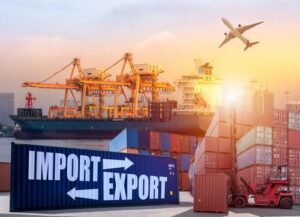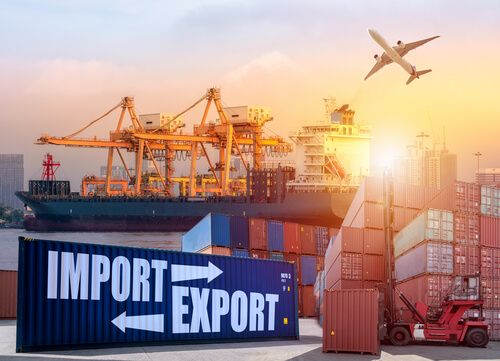The value of the trade deficit between Kenya’s imports and exports has now grown to more than 1.3 trillion Kenyan Shillings. This is occurring even after a number of policies were implemented in a bid to reverse or at least curb said deficit.

For January to October of 2022 the costs of importing food, industrial raw materials, and fuel increased the goods trade gap for Kenya by almost a quarter while also having a significantly negative effect on the nation’s official currency; the Kenyan Shilling and on the job possibilities for young people in Kenya.
The importation and exportation trade deficit for Kenya, rose from 1.11 trillion Kenyan Shillings in 2021, to 1.37 trillion Kenyan Shillings due to a number of interferences in the worldwide supply chains that led to corresponding increases in the costs incurred during the importation of goods.
Read Also: Kenya Set To Allow Duty-Free GMO Maize Imports For Six Months
The increase of 256.60 billion Kenyan Shillings or 23.09 percent in goods trade deficit occurred at a period in time when traders were faced with higher shipping costs at a time when there was a shortage of dollars as a result of incongruity in demand and supply.
The costs for essential commodities like Paper, Wheat, Steel, petroleum products, and edible Oils reached new heights earlier on in 2022 as a result of the interferences in the worldwide supply chains that were further enhanced due to the Russia and Ukraine war which began in February of 2022 and is still going on.
Read Also: Bank M-Pesa Fees Are Back Thanks To CBK
This meant that traders in Kenya had to spend more in United States Dollars (USD) in order to purchase similar or the same number of commodities that they had purchased for less in 2021.
Data by the Kenya National Bureau of Statistics (KNBS) revealed that the spending on importations for the ten (10) month period of January 2022 to October 2022 passed 2 trillion Kenyan Shillings due to a large extent, to the costs of foodstuff, industrial supplies and fuel.
Read Also: Safaricom Slashes Rates For Monthly Bundle Packages
The importation bill for Kenya grew by 21.89 percent year on year to almost 2.10 trillion Kenyan Shillings during the period in review and is significantly higher than the 19.69 growth that was achieved in earnings from Kenya’s exports which hit 728.2 billion Kenyan Shillings.

Economists believe that the increasing trade deficit has a negative effect on the job market in Kenya especially now when the number of skilled youths is on the rise at a time when a substantial part of the revenue generated in Kenya is channeled towards the purchasing of goods from outside the country. This in turn results in increases in production and job creations in all source markets.
The importation and exportation deficit is also putting more pressure on the Kenyan Shilling due to the increase in demand for the United States Dollars (USD) and supply not meeting that demand.
Read Also: Baseline Architects Limited Stopped From Pursuing 1.4 Billion Kenyan Shillings From NHIF
In 2022 the Kenyan Shilling has already lost around 8.76 percent of its overall value when put against the United States Dollar (USD) as at the time of putting this article together, to average out at around 123.05 Kenyan Shillings for every United States Dollar (USD) due to a larger demand for the foreign currency.
In the past couple of years, the East African nation of Kenya has faced some difficulties in closing the import and export trade gap due in part to its dependance on the exportation of farm produce like Coffea, horticulture and Tea all of which to a significant extent, are sold raw and have generated substantially smaller earnings.
A large number of traders in Kenya have been exporting raw produce as a result of the much higher taxes imposed on processed products and semi-processed products in markets like the European continent. Said traders worry that the exports would not be as competitive in the worldwide markets.
The Chief Executive of the Kenya Association of Manufacturers (KAM); Antony Mwangi made it known that, “Kenyan products are competing with products from all over the world and, therefore, we need as a country and even at factory level to be globally competitive.”
Read Also: Peer-To-Peer Network Cashlink Is Now On Binance
He added that, “If you look at some of the goods that we sell [abroad] like apparel, even with duty-free access to the US market, we are still 15 to 20 per cent more expensive than our competitors in Central Asia like Bangladesh and Sri Lanka. The reason is that production cost in Kenya is very high because of expensive power, water and labour.”

The trade information revealed that the imports were mostly increased due to the increased expenditure on the shipping of petroleum products.
For exports, their growth was negatively affected by a drop in earnings from horticulture.
Read Also: Safaricom Set To Transform Into A Holding Company
During the ten (10) month period of January 2022 to October 2022 the spending on lubricants and fuel, boosted by as much as 89.26 percent to 553.29 billion Kenyan Shillings. This is an indicator of the astronomically high cost of fuel which in turn led to the previous government implementing subsidies so as to protect Kenyans from the negative impacts from inflation.
Fuel subsidies ended up costing taxpayers in Kenya 81 billion Kenyan Shillings in the financial year ending in June of 2022, a further indicator of the negative effect the subsidies which were put in place with good intentions, had on Kenya’s revenue.
Read Also: Safaricom and M-Pesa Will Be Seperate Entities By January 2023
Following the high cost of the subsidies the new administration under President William Ruto moved to remove said subsidies on Petrol in September of 2022. The government however, opted to continue to implement the subsidies placed on Kerosene and Diesel to also protect Kenyans from the significant rise in the overall cost of living.
In October of 2022 the Diesel prices worldwide hit new highs, going as much as seventy (70) percent higher than where it was just a year before (2021). The in its price to the price of Crude Oil also went 425 percent more.
Read Also: Safaricom Launches New Interest Free Credit Service For Goods Purchases Via M-Pesa
Autonomous intergovernmental organization based in Paris, France; International Energy Agency (IEA), made it known that the production of Diesel was affected by the stretch in capacity which began sometime before the war between Russia and Ukraine began with Russia invading Ukraine in February of 2022.

According to the International Energy Agency (IEA), this occurred after the shutdown of a 3.5 million barrels each day of refinery capacity in Russia since the Coronavirus pandemic began.
The International Energy Agency (IEA) is a global organization that provides analysis and policy guidelines with regards to the Oil sector.
The Kenya National Bureau of Statistics (KNBS) revealed that the expenditure on food importation also increased by 15.48 percent to 201.99 billion Kenyan Shillings as commodities like edible Oil and Wheat reached record high prices. For non food industrial supplies, they rose by 15.28 percent to 783.07 billion Kenyan Shillings.
Read Also: Introducing Safaricom and Visa’s M-Pesa GlobalPay Virtual Card
In the first nine months of 2022 (January to September) the earnings from Tea exports rose by 25.47 percent to 119.97 billion Kenyan Shillings. For earnings from Coffee exports, those grew by half to hit 31.43 billion Kenyan Shillings during the same nine month period in review.
Even with those gains, the overall earnings achieved from Kenya’s exports were still substantially affected by the 38.46 percent drop in earnings from Horticulture which fell to 48.04 billiion Kenyan Shillings during the nine month period in review.
How informative was this particular article? Are there any other news topics, categories, or How To topics, that you would like us to write on? Feel free to reach out to Nexbit KE in the comment section.


